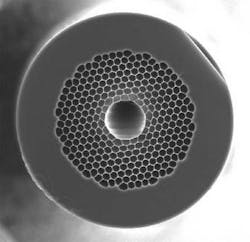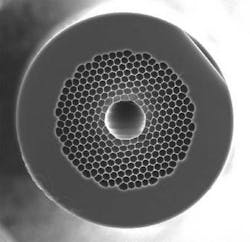OFC postdeadline sessions show technical vigor
While flipping through the papers presented at the postdeadline sessions at this year's Optical Fiber Conference (OFC; Los Angeles, CA; Feb. 22–27), it is almost possible to pretend that the telecom "bubble" never popped. The bandwidth glut rather muted the tone of the hero experiments; no one stood up to claim a new record for squeezing more than 10 Tbit/s through a single fiber. But researchers continue pushing ahead with cutting-edge technologies like optical packet switching, high-capacity transmission over transoceanic distances, and extremely high-efficiency transmission. The market may be in the doldrums, but good stuff continues to come out of the labs.
Packet switching has demonstrated its worth on the Internet, but it requires switches that can read the first bits of a packet and use that information to route the packet on its way. Today's network uses high-speed electronic switches, but there has been much talk about optical packet switching for future higher-speed networks. At OFC, Dan Blumenthal's group at the University of California at Santa Barbara reported cranking the data rate up to a record 160 Gbit/s for variable-length packets using the promising technique of all-optical label switching.
In all-optical label switching, the address label is transmitted separately from the data packet, which typically is held in a buffer while the switch operates on the label data and generates a new optical label that is then attached to the data packet. The label is transmitted at a slower speed than the data, and the packet may be converted to a different wavelength. The Santa Barbara group used 10-Gbit/s labels to route packets transmitted at 160 Gbit/s. They also demonstrated simultaneous up- and downconversion of the signal wavelength using Raman-enhanced cross-phase modulation, and removal and rewriting of optical labels. They reported power penalty of only 0.2 dB with so-called 2R (amplification and reshaping) regeneration.
40-Gbit/s channel rates
Development of differential phase-shift keying (DPSK) and balanced detection has made 40-Gbit/s channel rates viable for long-haul, high-speed wavelength-division-multiplexing experiments. At OFC, a team led by Gabriel Charlet of Alcatel Research and Innovation (Marcoussis, France) used those techniques to span transatlantic distances at a record 6 Tbit/s. Earlier experiments had relied on return-to-zero (RZ) pulse carving for high channel rates. But the Alcatel group modulated 42.7-Gbit/s channels with raw DPSK output, allowing them to reach an information spectral density of 0.8 bit/s/Hz with 50-GHz channel spacing. They packed 72 channels into the C-band and 77 into the L band, with Raman amplifiers spaced about every 65 km in a recirculating loop, with output above the minimum required for forward-error correction after 6120 km. Transmission results were similar with and without RZ pulse carving, showing the added complexity of pulse carving was not necessary.
Even higher spectral efficiency—1.14 bit/s/Hz—was reported by Noboru Yoshikane of KDDI R&D Laboratories (Saitama, Japan). It's the first time anyone has achieved more than 0.8 bit/s/Hz spectral efficiency without polarization multiplexing, which adds considerably to system complexity. They used differential quadrature phase-shift keying, which encodes two bits into each optical symbol. Laser outputs were passed through a pair of 42.7-Gbit/s modulators for total modulation of 85.4 GHz, with odd and even channels interleaved into 70-GHz channel slots. Using this approach, they were able to transmit 4 Gbit/s within 27.6 nm in the C-band through 300 km of fiber.
Photonic-bandgap fibers
Photonic-bandgap fibers continue to be hot, with the losses of hollow-core versions reduced to a record 1.7 dB/km by a team from Blaze Photonics and the University of Bath (both of Bath, England). That number marks a big improvement from the previous record, 13 dB/km, reported at the European Conference on Optical Communications in September 2002, although it remains well above the 0.15 dB/km minimum of the best solid-core conventional fibers. Developers hope they can further reduce attenuation in hollow-core fibers, in which light avoids the Rayleigh scattering and infrared absorption in bulk glass (see figure). The Blaze-Bath group reported that loss in their fiber should be dominated by mode coupling and scattering at the glass-air interface inside the fiber, factors they expect to scale with the inverse third power of the wavelength. They say it seems likely that hollow-core silica fibers will have minimum loss at 1800 to 2000 nm, well beyond the 1550-nm minimum of conventional silica fiber.

